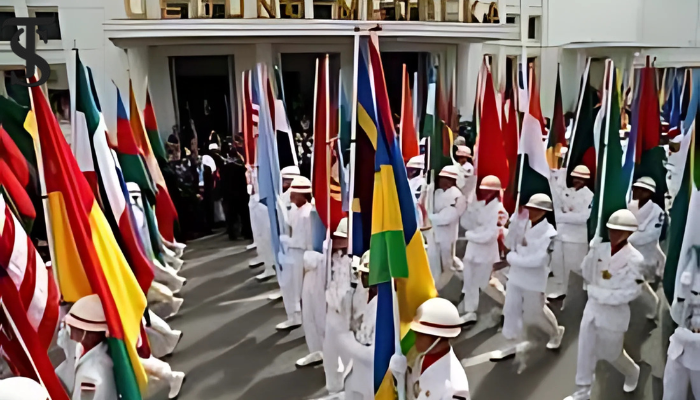BRICS: Purpose, Power, and the Threat to Dollar Dominance

The countries that make up BRICS—Brazil, Russia, India, China, and South Africa, along with five recent additions—form an informal coalition of emerging economies aiming to expand their influence in global affairs. BRICS, established in 2009, was founded on the belief that international institutions have been too heavily dominated by Western powers and are not sufficiently serving developing nations. The coalition has sought to harmonize its members’ economic and diplomatic agendas, establish new financial institutions, and reduce dependency on the U.S. dollar.
Nevertheless, BRICS has faced internal divisions on several matters, such as its members’ differing stances on relations with the United States and the Ukraine conflict. Expanding membership has amplified the group’s clout but also introduced new tensions. While some analysts caution that the coalition could disrupt the Western-led global order, skeptics argue that its goals, like creating a shared currency or an effective alternative to existing institutions, encounter substantial obstacles.
Why does BRICS matter?
Although BRICS is not a formal organization, it is a coalition of non-Western economies that work together on economic and diplomatic goals. The BRICS countries aspire to counterbalance the Western perspective that dominates major multilateral institutions, including the World Bank, the Group of Seven (G7), and the UN Security Council.
The group’s 2024 expansion carries notable geopolitical weight. The ten BRICS nations now represent over a quarter of the global economy and nearly half of the world’s population. This enlargement could impact the Gaza and Ukraine conflicts, shape the global economic order, influence China-West competition, and contribute to global clean energy efforts.
Yet, with this growth comes new challenges, as increasing opposition from Western nations and internal divisions test the bloc’s cohesion. How BRICS members manage these tensions will determine whether they can forge a more unified global voice.
Origins of BRICS
The term “BRIC” originated with economist Jim O’Neill in 2001, who noted the rapid growth potential of Brazil, Russia, India, and China as a challenge to dominant G7 economies. Russia initiated the first gathering of these nations in 2009, aiming to counterbalance Western influence. South Africa joined in 2010, completing the five-member group that lasted for over a decade. The 2023 BRICS summit marked a new wave of expansion, with invitations extended to six additional countries: Argentina, Egypt, Ethiopia, Iran, Saudi Arabia, and the United Arab Emirates (UAE). Argentina later declined to join under new leadership, while Saudi Arabia delayed formal entry.
BRICS Activities and Goals
The heads of BRICS states meet annually, with each member country taking a one-year rotational chairmanship to set priorities and host a summit. BRICS functions as a consensus-driven, informal group without a formal charter, secretariat, or common funds. Its activities center around key themes:
- Representation in Global Organizations: BRICS advocates for greater representation in multilateral institutions, aiming to form a unified front for emerging economies. The group supports reforms of existing institutions, like expanding the UN Security Council, and coordinates stances on issues like the Iran nuclear program and conflicts in Afghanistan, Gaza, Libya, and Syria.
- Economic Policy Coordination: In response to the 2008 global recession, BRICS prioritized economic cooperation on trade, export restrictions, and investment. Annual foreign direct investment (FDI) among BRICS countries surged from 2001 to 2021, though it has slowed in recent years.
- Reducing Dollar Reliance: BRICS countries have expressed dissatisfaction with the dominance of the U.S. dollar, which leaves them vulnerable to Western sanctions. The coalition promotes de-dollarization through local currency trade and has explored the idea of a shared BRICS currency.
- Alternative Financial System: The BRICS-created New Development Bank (NDB) and Contingent Reserve Arrangement (CRA) are intended as alternatives to the World Bank and International Monetary Fund (IMF), supporting South-South cooperation and reducing reliance on Western-led institutions.
Effectiveness of BRICS Financial Institutions
The NDB and CRA serve as alternatives to the established Bretton Woods system, designed to offer more equitable financial solutions for developing countries. These institutions focus on supporting infrastructure and sustainable development projects, particularly in clean energy, transportation, and social development. However, limitations remain: the NDB’s smaller scale and limited resources restrict its ability to fully replace institutions like the World Bank. Critics also point out the need for more robust environmental and social safeguards.
Challenges in Launching a BRICS Currency
Efforts to reduce reliance on the dollar have included proposals to introduce a common BRICS currency, championed by leaders such as Brazil’s President Luiz Inácio Lula da Silva. However, creating a BRICS-wide currency would necessitate complex financial compromises and a high level of economic coordination. Given the dollar’s dominant role in global trade, many experts doubt a new BRICS reserve currency could offer the stability or trust needed for widespread adoption.
Internal Divisions and Expanding Membership
Despite shared objectives, BRICS members face ongoing tensions and competitive dynamics. Border disputes between China and India, and geopolitical rivalries within the bloc, complicate decision-making. Russia’s invasion of Ukraine has intensified these rifts, with some BRICS members staying neutral or seeking a middle ground amid Western sanctions. Meanwhile, domestic instability in countries like Brazil and South Africa has raised questions about the bloc’s internal stability.
Expansion has introduced new complexities, with China and Russia advocating for growth, while Brazil and India express caution over losing influence. The recent addition of Egypt, Ethiopia, Saudi Arabia, and the UAE broadens BRICS’s regional scope but risks heightening existing rivalries, such as those between Saudi Arabia and Iran. Some new members, like Iran, openly criticize U.S. influence, while others maintain closer ties with Western allies, creating a diverse mix of perspectives.
Western Response and Future Prospects
Western countries have largely downplayed BRICS’s expansion, with U.S. officials stating they do not view the bloc as a geopolitical rival. However, some European leaders see the growth of BRICS as a signal that Western policies may need to adapt to address developing countries’ concerns.
Looking forward, BRICS members plan to explore new partnerships and expand their influence through additional membership. Since Russia held the 2024 BRICS presidency at this week’s summit, the coalition prioritized local currency trade and financial system reforms, setting the stage for BRICS’s evolving role in a multipolar world order.
Nasir Imtiaz is the content strategist of The Spine Times.







3 Comments